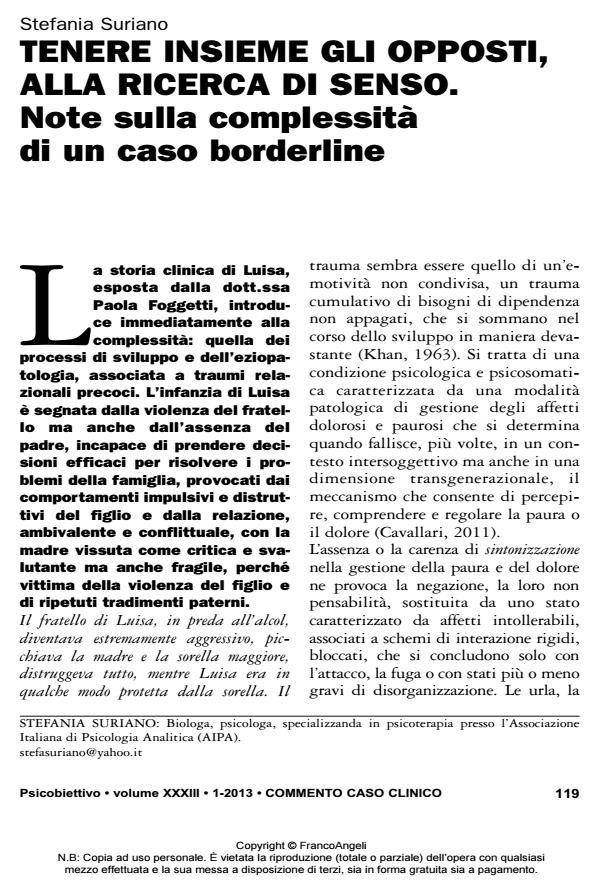Holding the opposites together, in search of a meaning. Notes on a complexity of a borderline case
Journal title PSICOBIETTIVO
Author/s Stefania Suriano
Publishing Year 2013 Issue 2013/1 Language Italian
Pages 5 P. 119-123 File size 186 KB
DOI 10.3280/PSOB2013-001009
DOI is like a bar code for intellectual property: to have more infomation
click here
Below, you can see the article first page
If you want to buy this article in PDF format, you can do it, following the instructions to buy download credits

FrancoAngeli is member of Publishers International Linking Association, Inc (PILA), a not-for-profit association which run the CrossRef service enabling links to and from online scholarly content.
This paper proposes a review of the clinical case of a borderline patient from the Jungian analytical psychology point of view,with references to other psychodynamic models. The severe symptoms of the patient, registered in the most critical moments as pathological dissociation, impulsive behavior and acting out, seem to represent a psychic short circuit, a defense against repeated and devastating traumatic states, identifiable as a psychological and psychosomatic condition: this is characterized by an incapability (or incapacity) to be aware of fear and pain, which are denied, when the mechanism that controls,perceives and regulates them fails repeatedly, also at the transgenerational level. The therapeutic relationship provides an important opportunity to change the expression of suffering from archetypal, explosive and undifferentiated affection into feelings, thus communicating the inner states of oneself to others and favouring a new dimension of interior change and development.
Keywords: Borderline; Cumulative Trauma; Complex; Mother; Suicide; Dissociation.
- Bion W.R. (1959) “Attacks on Lincking”, Internationl Journal of Psychoanalysis, vol. 40 (trad. it. Attacchi al legame, in Analisi degli schizofrenici e metodo psicoanalitico, Armando, Roma 1970)
- Cavallari G. (2011) “La volontà di cambiamento in Il Nuovo. Forme di apertura all’ulteriore”, Atti del XV Convegno Nazionale CIPA, 2010
- Fonagy P. (2001) Attachment Theory and Psychoanalysis, Other Press (USA) (trad. it. Psicoanalisi e teoria dell’attaccamento, Raffaello Cortina, Milano 2002)
- Jung C.G. (1907) Psichogenese der Geistekrankeiten, Walter Verlag, Olten (trad. it. Psicogenesi delle malattie mentali, Il complesso a tonalità affettiva e i suoi effetti sulla psiche, in Opere, vol. 3, Bollati Boringhieri, Torino, 1996)
- Jung C.G. (1921) Psychologische Typen, Rascher Verlag, Olten (trad. it. Tipi psicologici, in Opere, vol. 6, Bollati Boringhieri, Torino, 1996)
- Jung C.G. (1934) Algemeines zur Komplextheorie, in Die Dynamik des Unbewussten, Racher Verlag, Olten (trad. it. Tipi psicologici, in Opere, vol. 8, Bollati Boringhieri, Torino, 1976)
- Jung C.G. (1935) Grundsatzlikes zur praktischen Psychoterapie, Rascher Verlag, Zurigo (trad. it. Principi di psicoterapia pratica, in Opere, vol. 16, Bollati Boringhieri, Torino, 1981)
- Jung C.G. (1952) Wandlungen und Symbole der Libido, Rascher Verlag, Zurigo (trad. it. Simboli della trasformazione – La lotta per la liberazione dalla madre, Bollati Boringhieri, Torino, 1973)
- Hillman J. (1965) Suicide and the Soul, Spring Comunications, Woodstock (trad. it. Il suicidio e l’Anima, Adelphi, Milano, 2010)
- Hillman J. (1975) Loose Ends: Primary Papers in Archetypal Psychology, Spring Publications, Woodstock (trad. it. Trame perdute, Raffaello Cortina, Milano, 1985)
- Kalshed D. (1996) The Inner World of Trauma. Archetipal Defenses of the Personal Spirit, Routledge, Londra (trad. it. Il mondo interiore del trauma, Moretti e Vitali, Bergamo, 2001)
- Khan M. (1964) “Ego distortion, cumulative trauma and the role of reconstruction in the analytic situation”, International Journal of Psychoanalysis, vol 45 (trad. it. Il concetto di trauma cumulativo, in Lo spazio privato del sé, Bollati Boringhieri, Torino 1979)
- Testa F. (2011) “Sogno e psicoterapia. Borderline e visione del mondo”, in “Il Nuovo. Forme di apertura all’ulteriore”, Atti del XV Convegno nazionale del CIPA, Milano
Stefania Suriano, Tenere insieme gli opposti, alla ricerca di senso. Note sulla complessità di un caso borderline in "PSICOBIETTIVO" 1/2013, pp 119-123, DOI: 10.3280/PSOB2013-001009